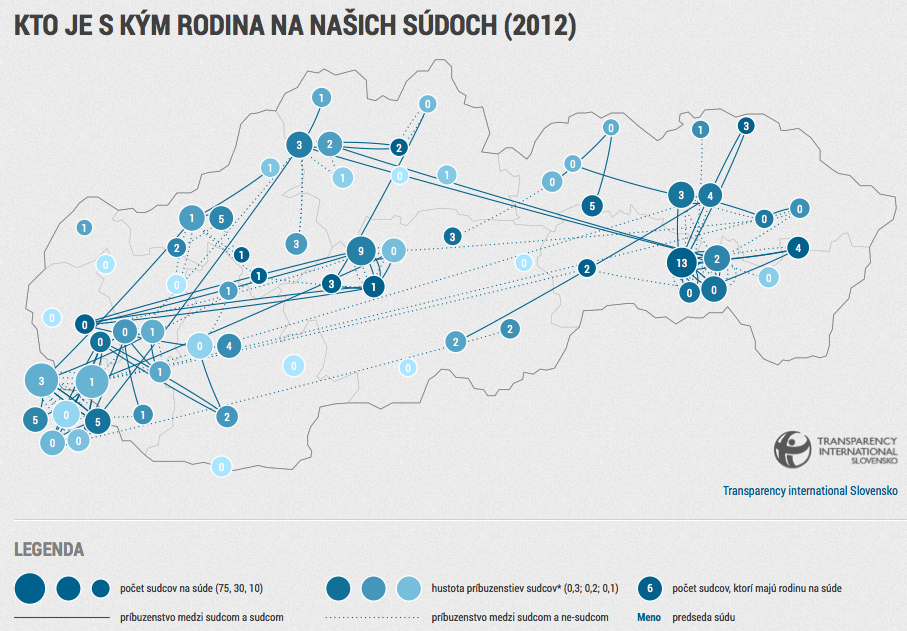OpenGov Voices: OpenCourts: Bringing transparency to the Slovak judiciary
Disclaimer: The opinions expressed by the guest blogger and those providing comments are theirs alone and do not reflect the opinions of the Sunlight Foundation or any  employee thereof. Sunlight Foundation is not responsible for the accuracy of any of the information within the guest blog.
employee thereof. Sunlight Foundation is not responsible for the accuracy of any of the information within the guest blog.
Samuel Spáč is a project coordinator and junior analyst at Transparency International Slovakia. In 2013 he graduated in Political Science at the Central European University in Budapest where he received the Best MA Thesis Award for his research on the development of judiciary in the Czech Republic and Slovakia. Currently he is working on his PhD at the Comenius University in Bratislava. Besides courts and politics he is passionate about soccer and cooking. Samuel can be reached at spac@transparency.sk.
According to the latest Global Corruption Barometer, the judiciary in Slovakia is the least trusted institution in the world, and 70% of Slovakians consider it to be corrupt. This is partly because the Slovak judiciary system has no external influence and enjoys a very high level of independence not only from other branches of power, but also from the general public. Last July, the OpenCourts portal (available only in Slovak and the first open data project dealing with the judiciary branch) was launched by Transparency International Slovakia. Its main goal is to make the Slovakian system more transparent and allow the public to control courts and judges in order to hold them accountable.
Since 2011, a lot of information on courts and judges has been made available through reforms aimed at opening up the judiciary. However, this data was scattered throughout several different government websites and was not easily searchable. For this reason, OpenCourts collects all information that is relevant and available and offers it to the public for free and in a user-friendly format. All in one convenient location! If you are interested in the project, the code is available on GitHub.
So what kind of information does one find on OpenCourts? As of Friday, November 8, there were more than 745,000 judicial decisions available on the website, including almost 400,000 records of past or future hearings held by the courts. This allows the public to see how often a particular judge holds hearings in order to decide a case. It also enables the user to read the said judge’s decisions and see interpretations of legal provisions. The website also includes some summary data about courts, such as the current number of judges at a court and at the same time enables users to easily find personalized judge profiles.

Each court’s page shows information on the average length of time spent on criminal, civil, business and child-care cases in the last three years. It also shows court rankings where users can compare courts and see which one hears cases in the shortest amount of time. The website also displays different statistics about the judges’ profiles. The public can find out when a judge was appointed to the position and the number of hearings and decisions registered under his or her name. One can also learn about an individual judge’s performance, such as the success rate of appeals to higher court following his or her decision, the number of backlog cases as compared to previous years or the number of fines a court was obliged to pay due to a judge’s bad decisions or unnecessary delays in judicial proceedings.
We use data from the judges’ property declarations to show whether a judge has family members or relatives working in the judiciary or at the ministry. OpenCourts also recently published a short article on courts with a map of family connections in Slovak courts.
Also included in OpenCourts is information on all judge profiles who applied to any position in the judiciary in the last couple of years, including their CVs and motivation letters — allowing the public to easily learn more about the judges’ education, prior experience and possibly discover something interesting about their motivations and intentions in judicial positions.
As explained above, the portal contains a variety of data from several different sources. Not all of this information is updated automatically though. Therefore, in order to sustain the quality of the information on the website, further financial support is required. Each year, it is necessary to obtain and process data which is often published in non-machine readable format or data that needs to be requested through the Freedom of Information Act.
Perhaps it is too early to evaluate the success of the portal, but so far the average number of visits is more than 10 times higher than visits to other open data portals in Slovakia — reaching as many as about 1,100 visits during each work day. The portal also has twice as many visits than the official governmental portal where judicial decisions are published. The feedback we have received from users is that our site is used by the general public, media and also legal professionals. Visitors to the portal also provided input on some of the information that should be on the site such as judicial decisions that ought to be published.
The ultimate goal of the website is to increase public pressure on judges and call for effective accountability against those that are continually under-performing.
Our future plan is to develop a more sophisticated methodology focusing on particular judges to evaluate their performance. Up until now, based on the data we gathered, we identified the worst performing courts in a short analysis (available in Slovak only). The analysis was also discussed by some of the country’s major print media. In the last couple of years, the debate about the judiciary in Slovakia has been quite heated, but our objective is to step aside from generalizing statements and inspire a rather data-driven discussion.
If you are interested in supporting this initiative, please consider a donation here.
Interested in writing a guest blog for Sunlight? Email us at guestblog@sunlightfoundation.com.

